Pothos and spider plants have their charm, but if you’re tired of green plants and are craving something different, houseplants with unusual coloration may be just the solution you’re looking for!
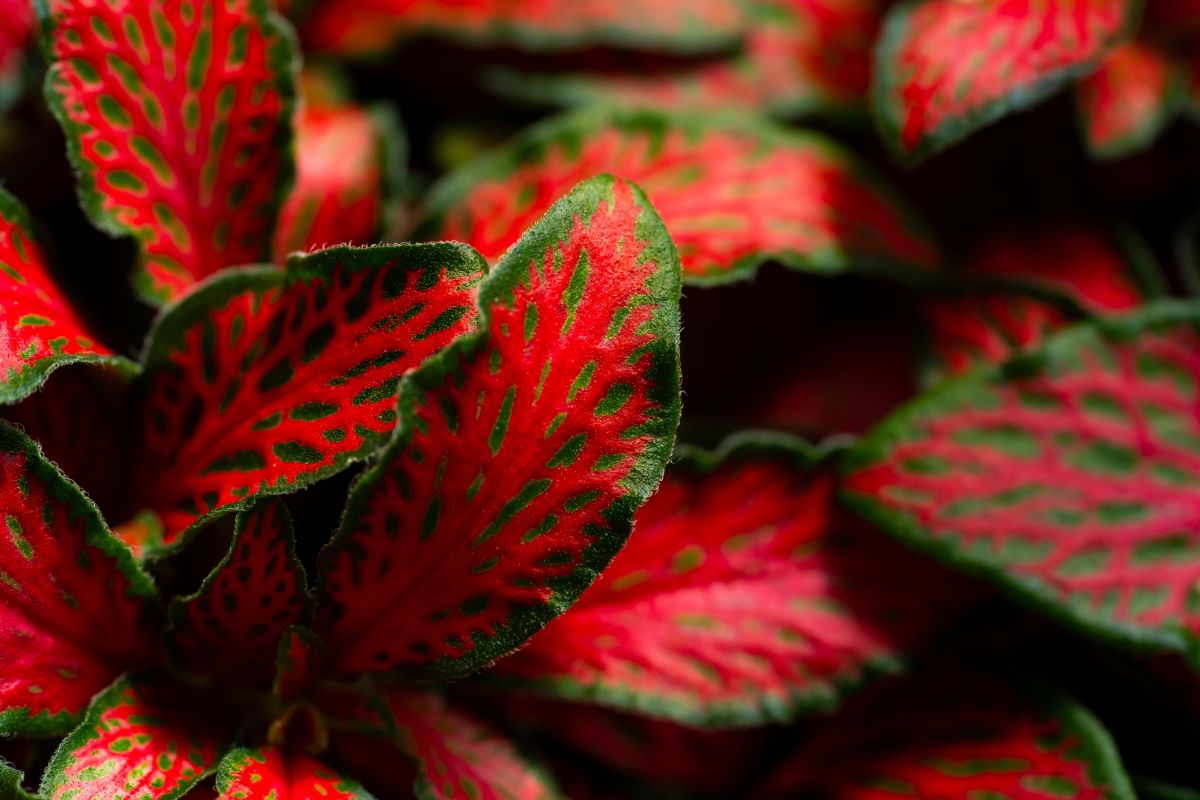
While most houseplants have green leaves and subtle flower colors, there’s a surprising array of uniquely colored houseplants on the market today. Some of these houseplants have bright purple leaves or cheerful yellow blooms, but if you aren’t shy with color, the boldest plants you can keep have radiant red flowers and leaves!
In the collection below, you’ll find the showiest indoor plants around. From bold, red blooms to saturated, crimson leaves, these plants have all the spectacular colors you could want.
Jump to:
- 25 red houseplants to fire up your collection
- 1. Chinese Evergreen (Aglaonema modestum)
- 2. Flamingo Flower (Anthurium andraeanum)
- 3. Polka Dot Plant (Hypoestes phyllostachya)
- 4. Nerve Plant (Fittonia albivenis)
- 5. Crotons (Croton spp.)
- 6. Cyclamen (Cyclamen persicum)
- 7. Lipstick Plant (Aeschynanthus spp.)
- 8. ‘Widow’s Thrill’ Kalanchoe (Kalanchoe blossfeldiana)
- 9. Moon Cactus (Gymnocalycium mihanovichii)
- 10. Bromeliads (Bromeliaceae spp.)
- 11. Pencil Cactus (Euphorbia tirucalli)
- 12. Poinsettia (Euphorbia pulcherrima)
- 13. Chenille Plant (Acalypha hispida)
- 14. Amaryllis (Amaryllis spp.)
- 15. Hibiscus (Hibiscus spp.)
- 16. Red Star Dracaena (Cordyline australis)
- 17. Rubber Plant (Ficus elastica)
- 18. Ti Plant (Cordyline fruticosa)
- 19. Red Edged Radiator Plant (Peperomia clusiifolia)
- 20. Crown of Thorns (Euphorbia milii)
- 21. Caladiums (Caladium spp.)
- 22. Coleus (Coleus spp.)
- 23. Desert Rose (Adenium obesum)
- 24. Rex Begonia (Begonia rex)
- 25. ‘Red Log’ Peperomia (Peperomia verticillata)
- Summary
25 red houseplants to fire up your collection
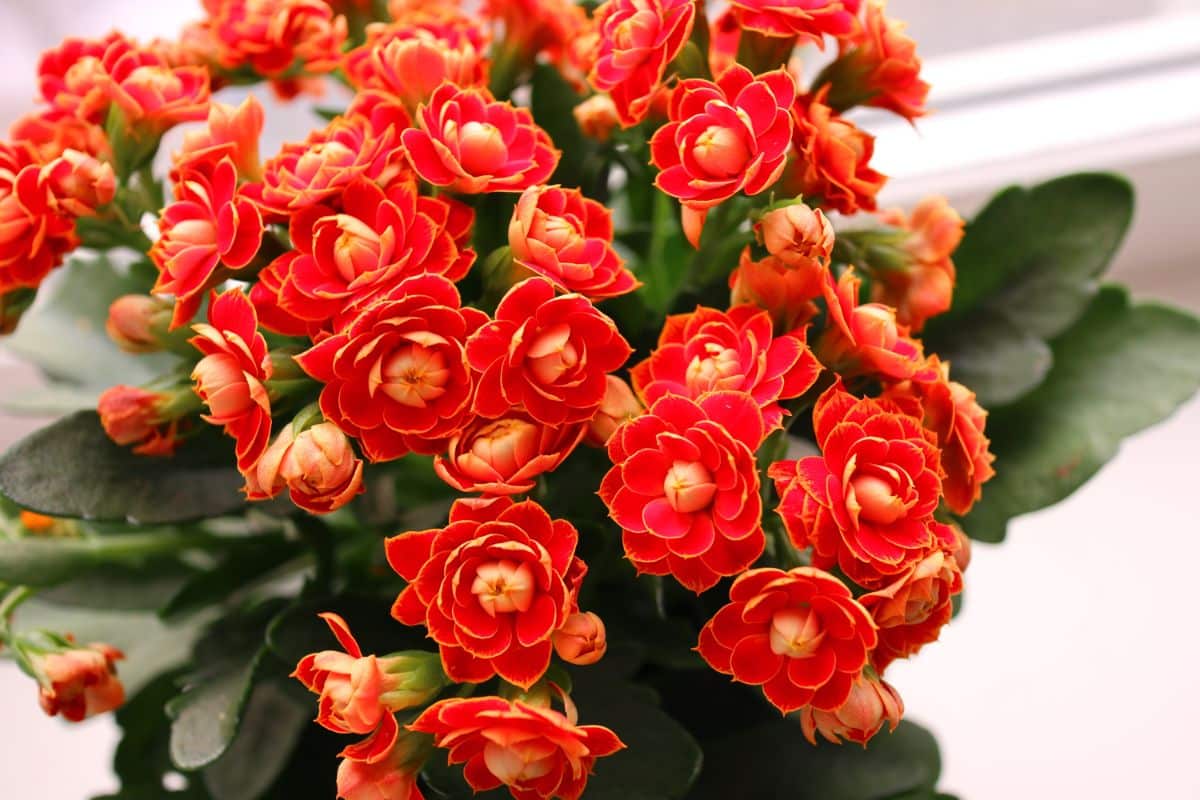
Houseplants have different needs and varying care requirements. To suit any houseplant parent, we’ve made sure to include both beginner-friendly and more challenging plants in the list below. So, no matter your plant care experience and gardening skill level, you’ll be able to find the perfect red houseplant for you right here!
1. Chinese Evergreen (Aglaonema modestum)
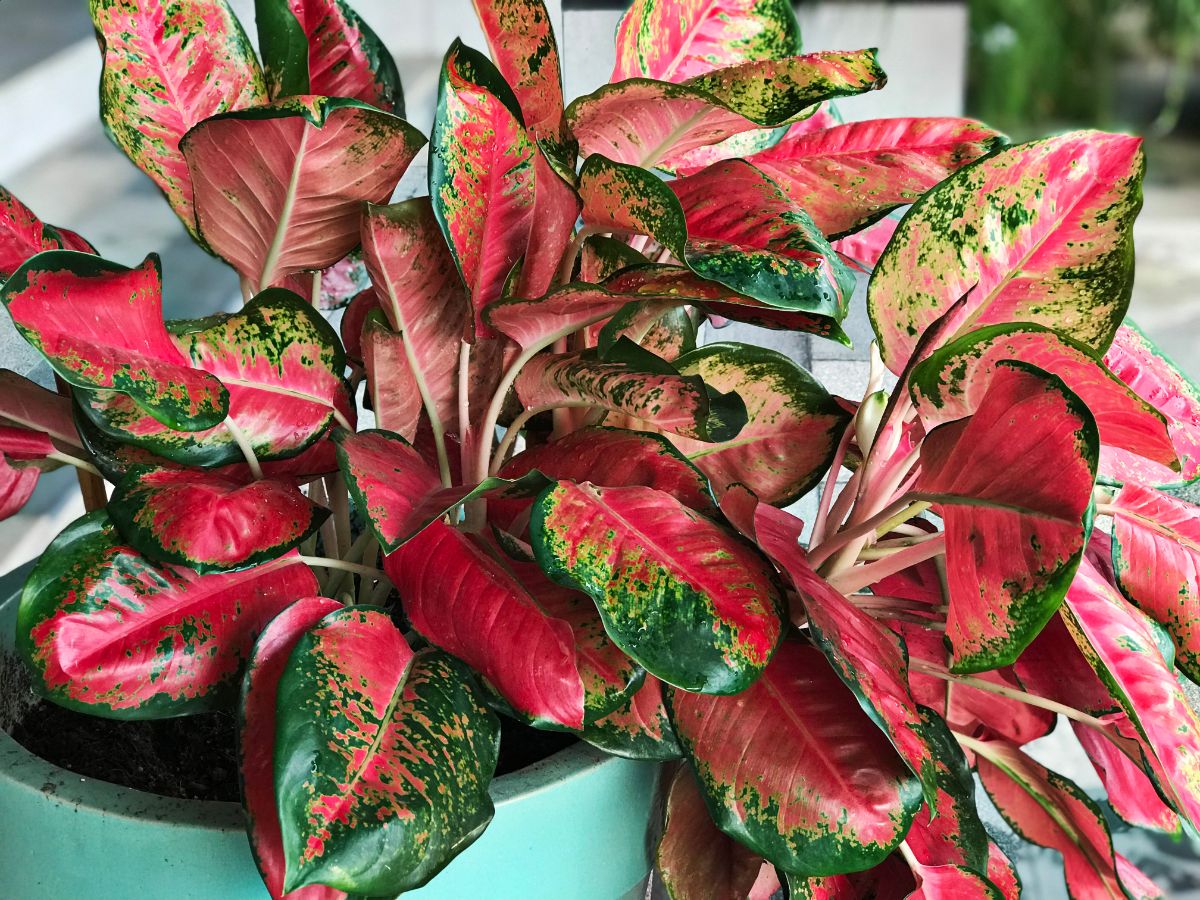
| Plant name: | Chinese Evergreen |
| Light requirements: | Bright, indirect light to low light |
| Water requirements: | Moderate |
| Toxic to pets? | Yes |
| Special features: | Beginner friendly |
If you’re looking for a red houseplant to add to your collection, Chinese evergreens are hard to beat. These attractive plants are easy to care for and common enough that you should be able to locate them at your local garden center. And while they come in different colors, the red Chinese evergreen variety is one of the showiest foliage plants around.
Chinese evergreens are mostly grown for their intensely colored foliage, but full-grown plants can also bloom inconspicuous flowers that look a bit like small peace lily blooms. Even beginning growers should have success keeping Chinese evergreens, but these plants will grow even better when humidity levels are kept between 60 and 70%. If you don’t have a humidifier, try placing your plant on a pebble tray to boost humidity levels.
2. Flamingo Flower (Anthurium andraeanum)
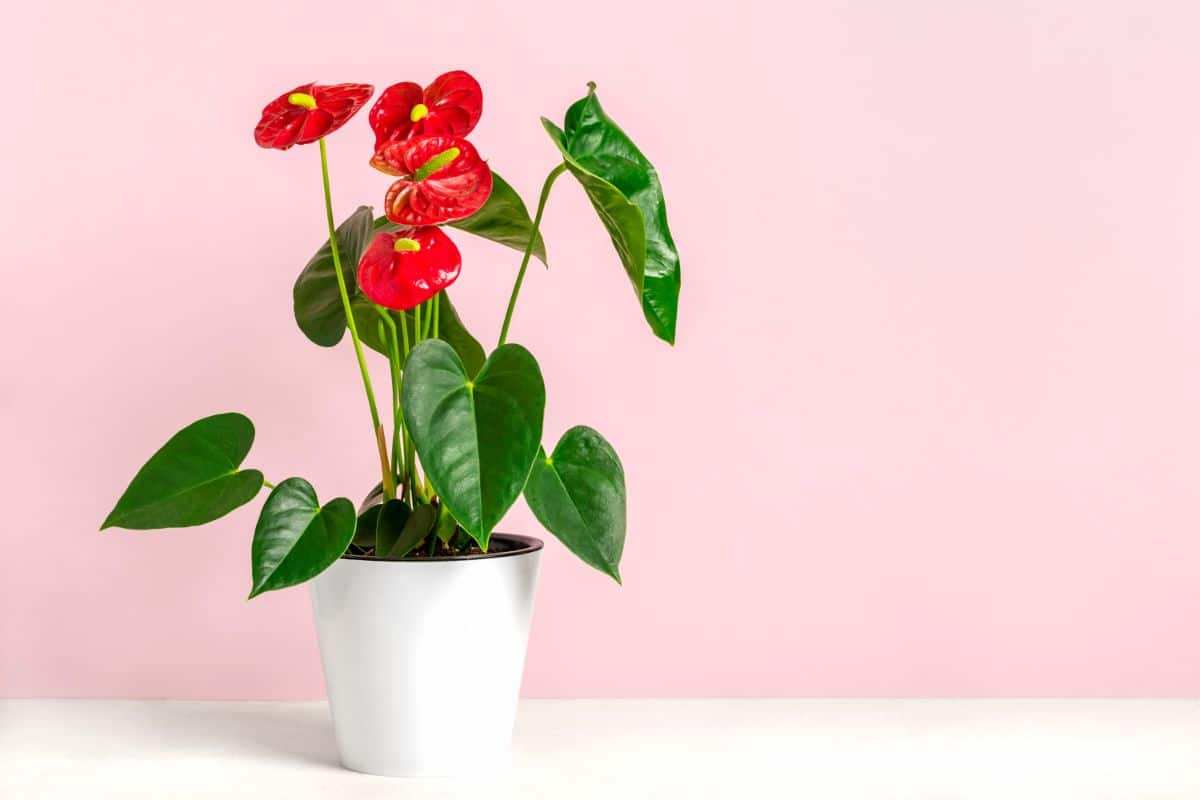
| Plant name: | Flamingo Flower |
| Light requirements: | Bright, indirect light |
| Water requirements: | Moderate |
| Toxic to pets? | Yes |
| Special features: | Showy flowers |
Flamingo flowers have a distinct look with large, heart-shaped blooms and glossy leaves. While these plants come in different colors, red flamingo flowers are particularly striking, and they’re sure to be the stars of your houseplant collection.
Native to Central and South America, flamingo flowers can be a bit picky about their care requirements. However, if you provide them with some extra humidity, you should be able to keep these plants happy indoors. Flamingo flowers are slow growers, but their flowers are long-lasting, and they can bloom year-round with proper care.
3. Polka Dot Plant (Hypoestes phyllostachya)
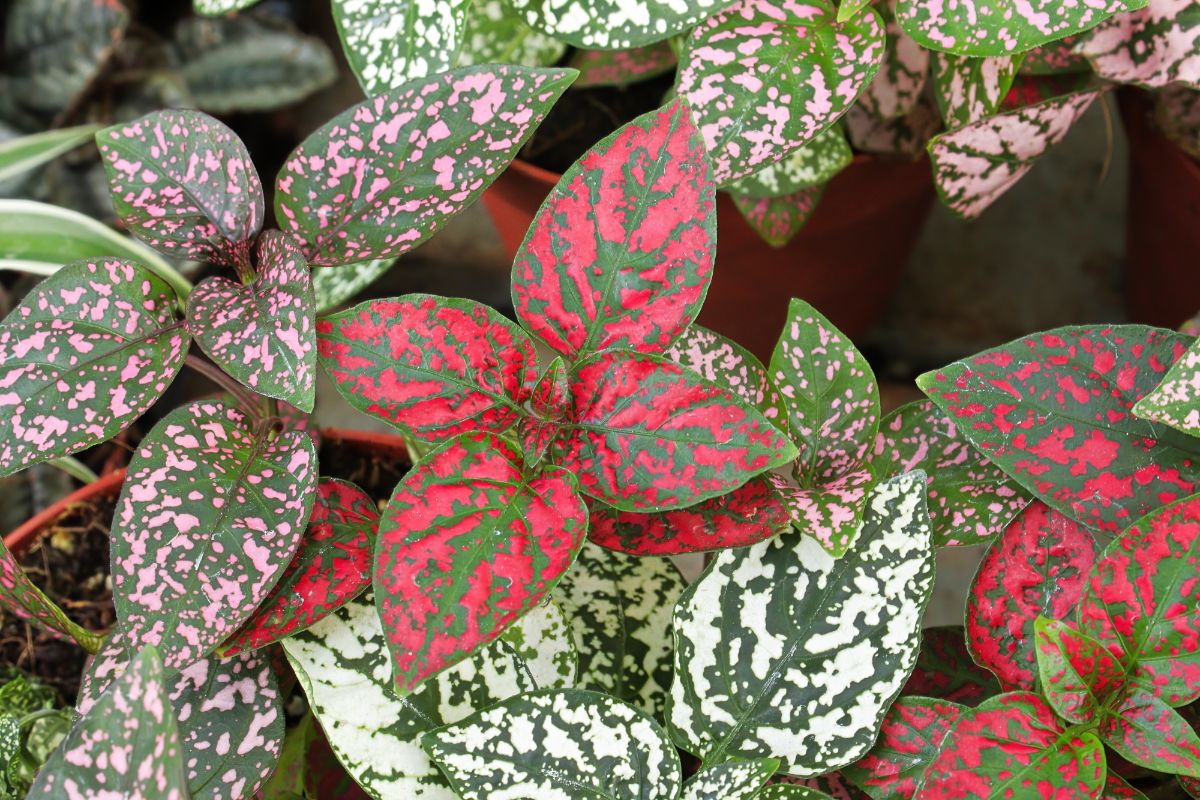
| Plant name: | Polka Dot Plant |
| Light requirements: | Bright, indirect light |
| Water requirements: | Moderate |
| Toxic to pets? | No |
| Special features: | Good for terrariums; Pet safe |
The Polka dot plant is known for its patterned leaves that come in a range of colors, but if you’re on the hunt for red houseplants, polka dot plants come in red too. Polka dot plants are another humidity-loving species, but they are small enough to keep in terrariums, which can simplify their care immensely. If you don’t keep your polka dot plant in a terrarium, be sure to water it often, as these plants can wilt dramatically if their soil dries out!
4. Nerve Plant (Fittonia albivenis)
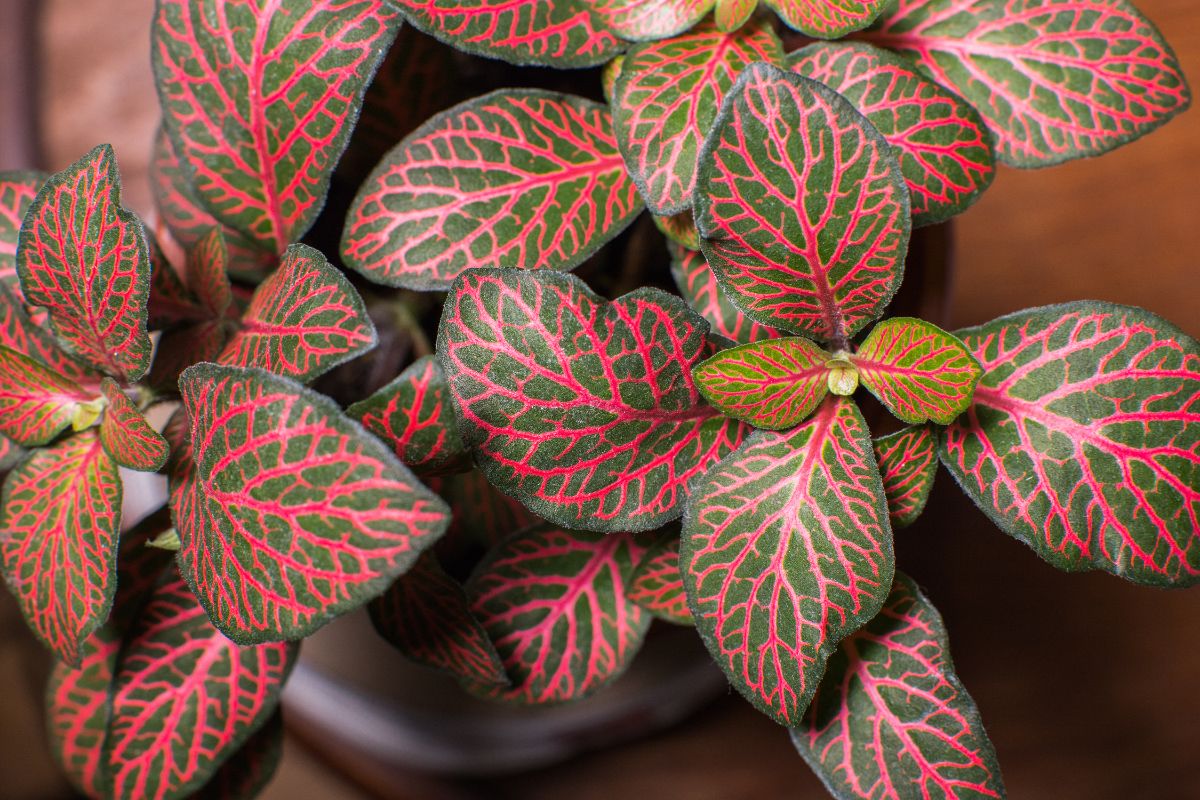
| Plant name: | Nerve Plant |
| Light requirements: | Bright, indirect light to low light |
| Water requirements: | High to moderate |
| Toxic to pets? | No |
| Special features: | Good for terrariums; Pet safe |
Nerve plants have a similar appearance to polka plants, although their leaves have different patterning. Like polka dot plants, nerve plants come in various colors, including white, pink, and red. They also prefer high-humidity environments and can be grown in terrariums or as tabletop plants as long as you give them some extra humidity.
5. Crotons (Croton spp.)
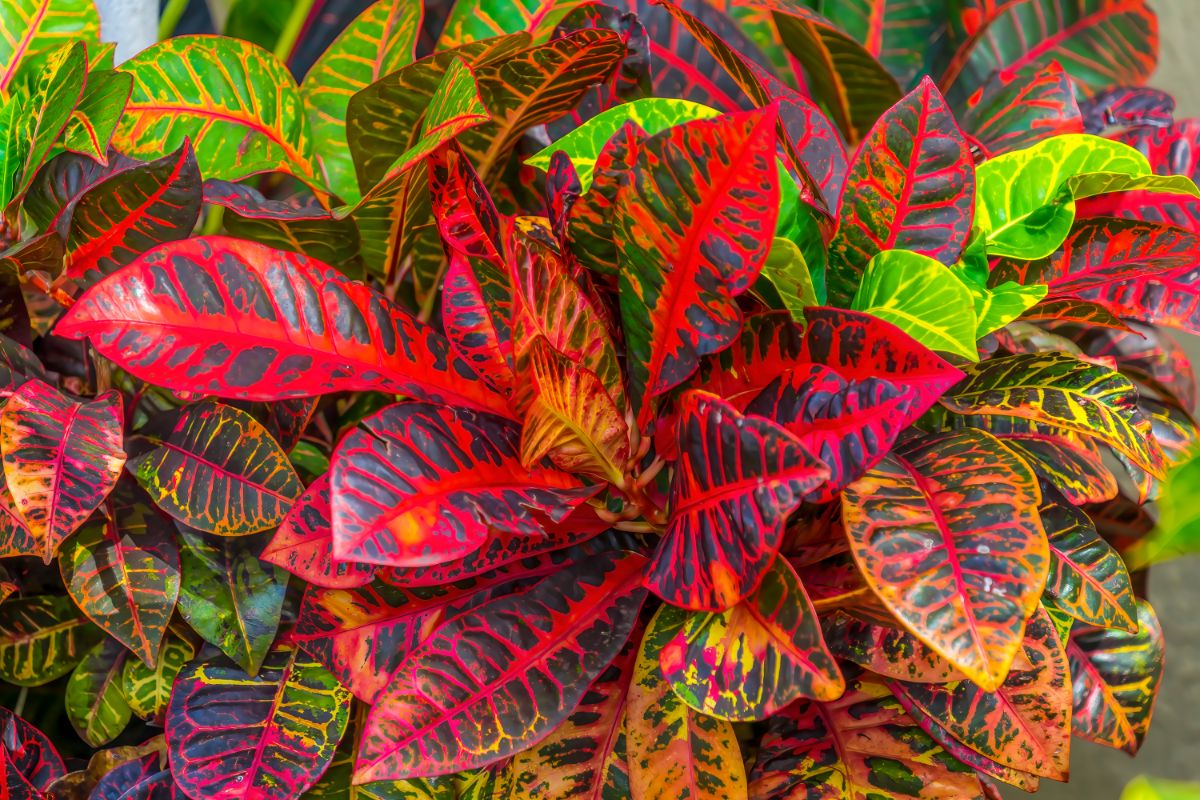
| Plant name: | Crotons |
| Light requirements: | Bright light to bright, indirect light |
| Water requirements: | Moderate |
| Toxic to pets? | Yes |
| Special features: | Beginner friendly |
Crotons are staples in autumn gardens, and they are often kept in container planters outdoors. But crotons are easy-going plants that also thrive in indoor environments. And if you love red plants, crotons are a top choice to keep because many varieties have lots of red coloration.
Crotons are known for their flamboyant leaves that often have splashes of bright colors, including green, yellow, orange, and red. While you can pick up an assortment of croton varieties, some of the most popular red croton types include ‘Red Iceton,’ ‘Zanzibar,’ and ‘Petra.’
6. Cyclamen (Cyclamen persicum)
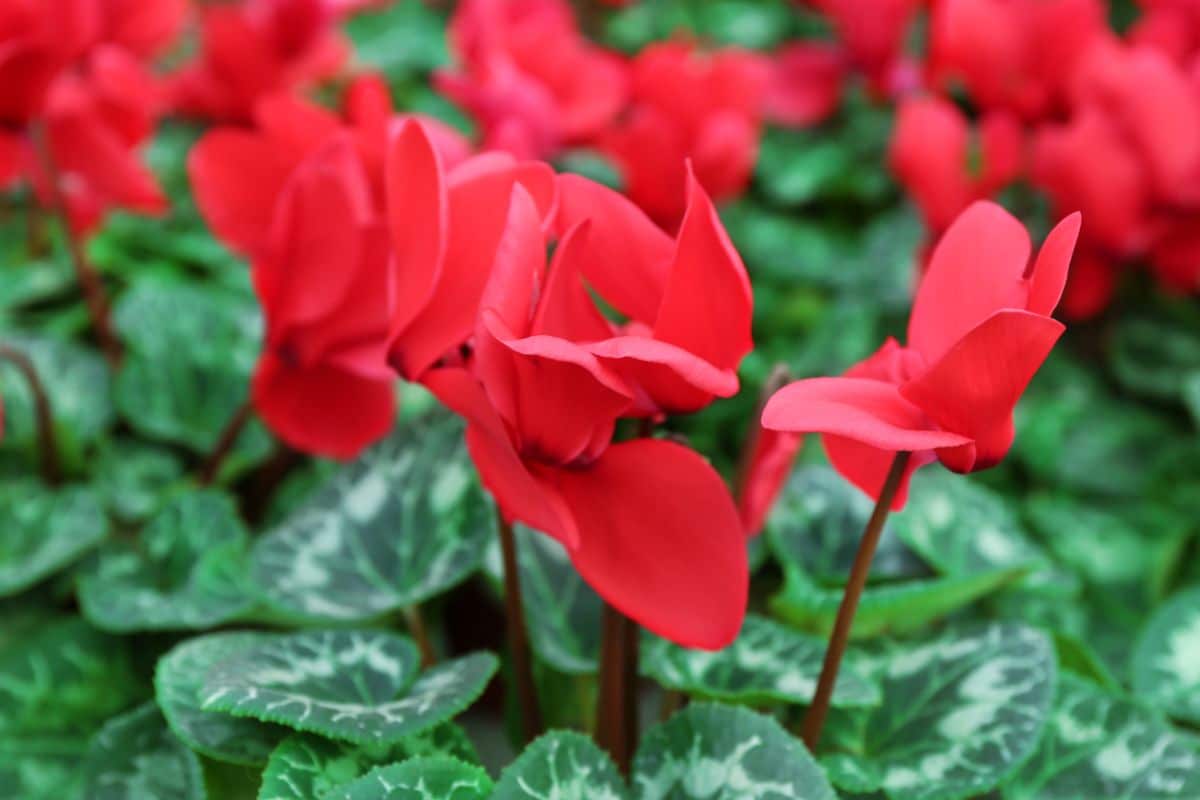
| Plant name: | Cyclamen |
| Light requirements: | Bright light to bright, indirect light |
| Water requirements: | Moderate |
| Toxic to pets? | Yes |
| Special features: | Beginner friendly; Showy flowers |
Most cyclamen varieties are native to the Mediterranean region, but these adorable plants make excellent houseplants too. Cyclamen are known for their patterned leaves and distinct flower forms, which come in pink, white, and, yes, red!
Cyclamen usually enters into a state of dormancy in spring or summer. At this point of the year, cyclamen plants can drop their leaves and appear to be dead. If this happens, don’t worry -- as long as the cyclamen tuber isn’t mushy, the plant is probably just dormant, and it will sprout new leaves in a few months.
7. Lipstick Plant (Aeschynanthus spp.)
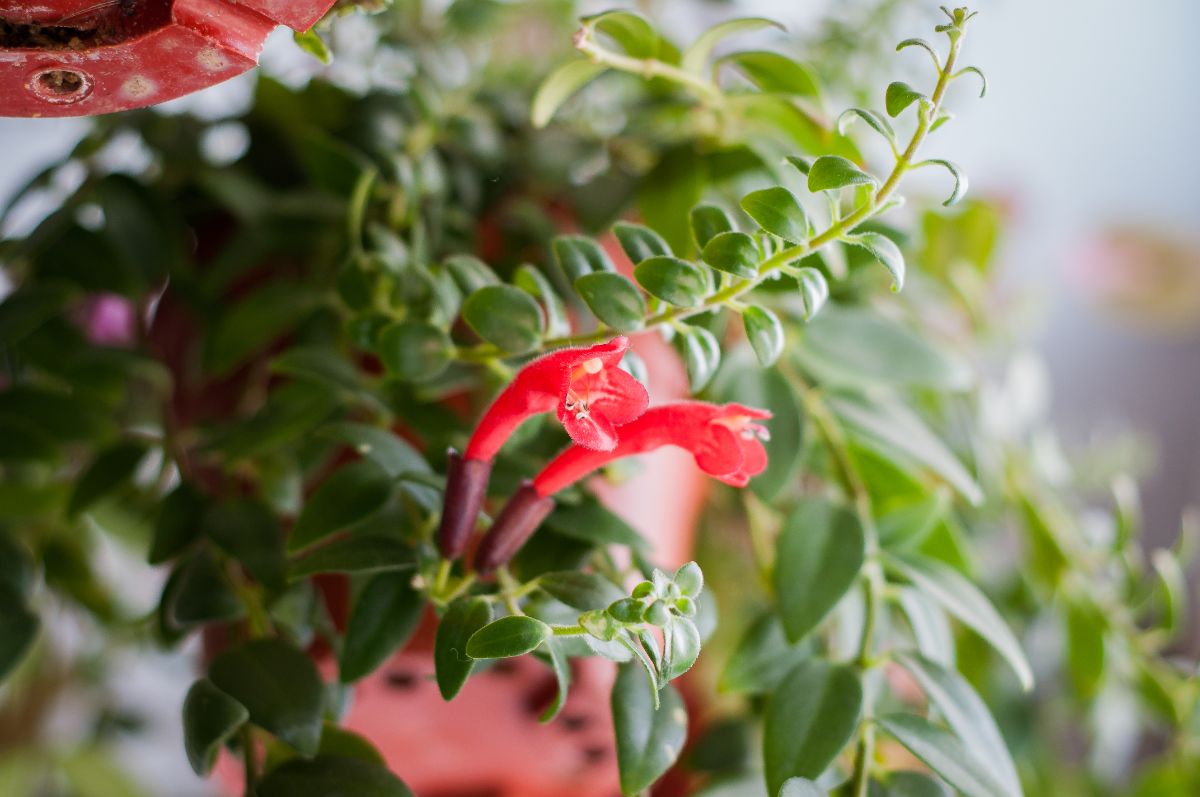
| Plant name: | Lipstick Plant |
| Light requirements: | Bright, indirect light |
| Water requirements: | Moderate |
| Toxic to pets? | No |
| Special features: | Good for hanging baskets; Pet safe |
The lipstick plant is a funky species that is sure to delight anyone who loves unusual houseplants. This plant is named for its bright red, tubular flowers, which are said to resemble tubes of lipstick!
Native to Malaysia, in the wild lipstick plant grows as an epiphyte on trees, and it winds its trailing vines along tree branches and bark. As a houseplant, a lipstick plant is perfectly suited for hanging baskets, but it can also be kept as a tabletop plant. Just be sure to provide this plant with a bit of extra humidity to prevent leaves from getting crispy in dry, indoor air.
8. ‘Widow’s Thrill’ Kalanchoe (Kalanchoe blossfeldiana)
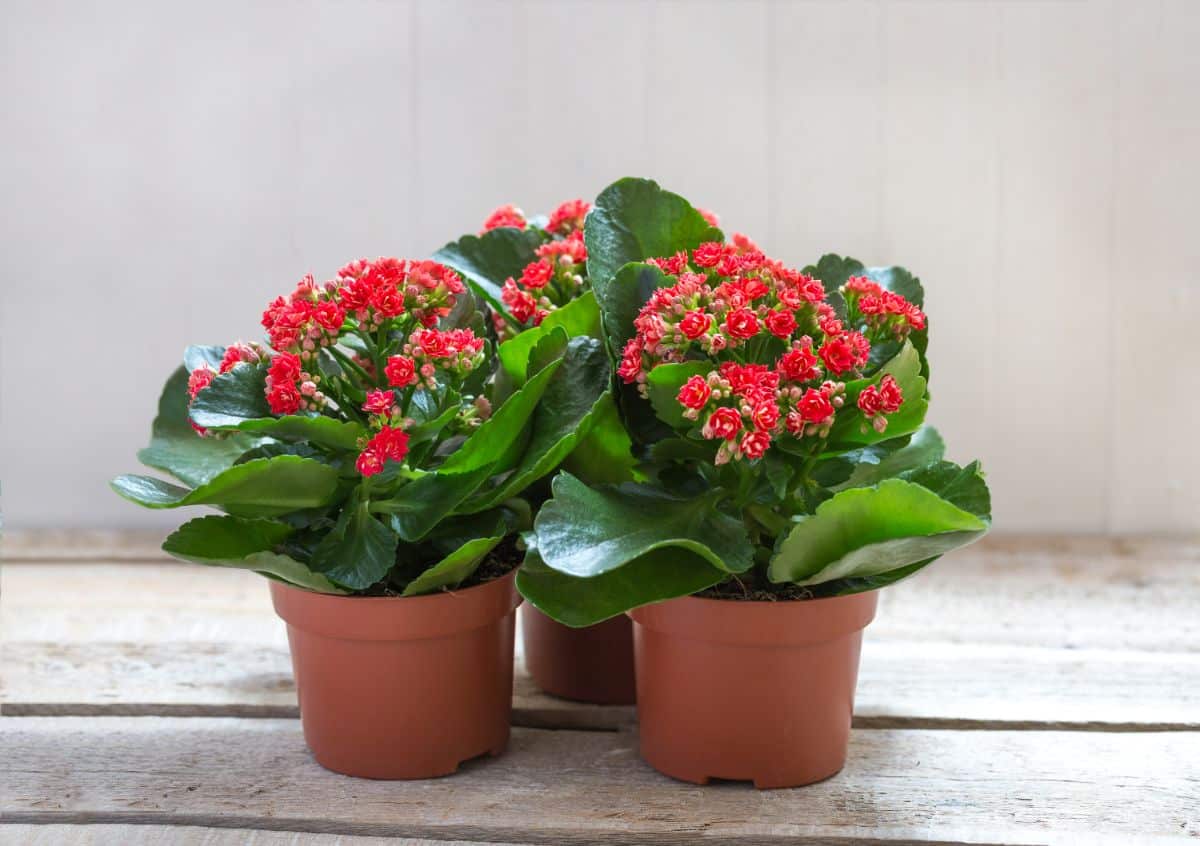
| Plant name: | Widow’s Thrill Kalanchoe |
| Light requirements: | Bright, indirect light |
| Water requirements: | Low |
| Toxic to pets? | Yes |
| Special features: | Beginner friendly; Low water needs |
Kalanchoe are some of the most popular succulent species around, and they are known for their undemanding nature. But if you love red plants, ‘Widow’s Thrill’ is the kalanchoe variety you need to be on the lookout for.
Also known as the florist’s kalanchoe, ‘Widow’s Thrill’ is a common variety, and it’s usually quite easy to find. This plant features bright green, toothed leaves and clusters of cheerful flowers in yellow, pink, orange, white, and red. Like other kalanchoes, ‘Widow’s Thrill’ needs very little water, and it’s a good plant to keep if you often forget to water your houseplants!
9. Moon Cactus (Gymnocalycium mihanovichii)
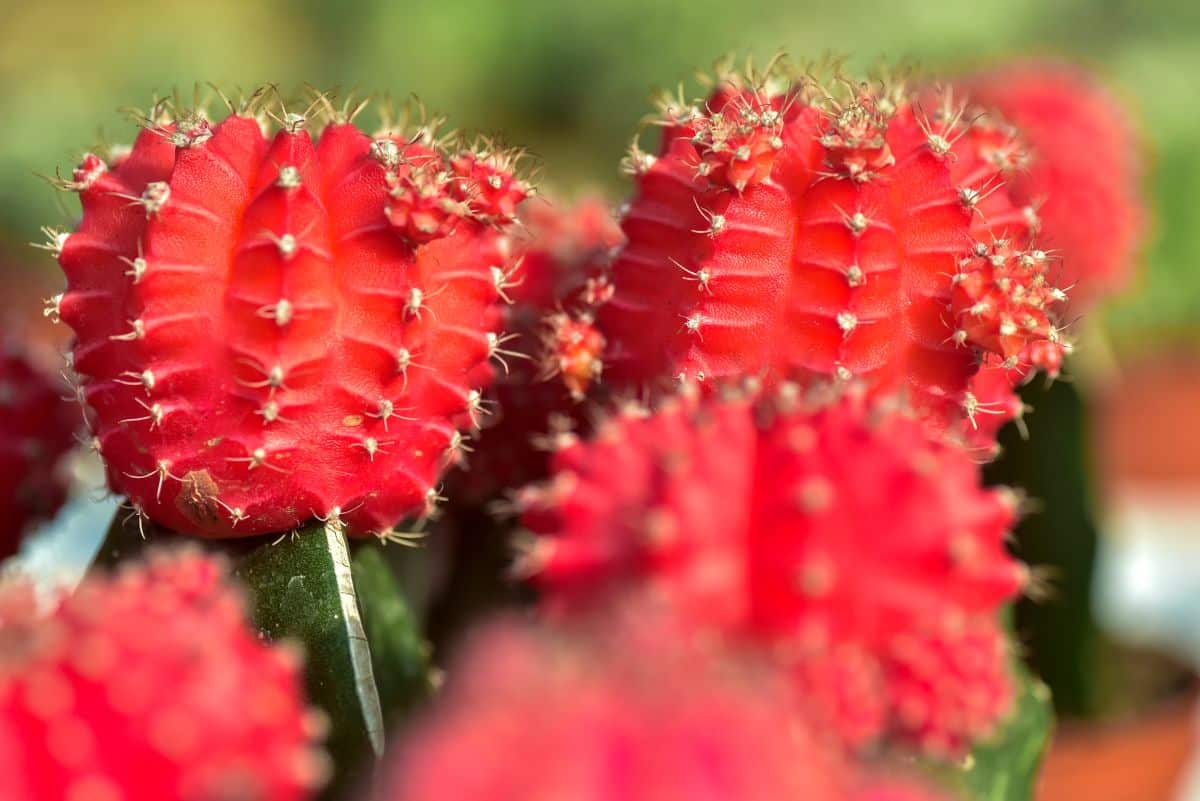
| Plant name: | Moon Cactus |
| Light requirements: | Bright, indirect light |
| Water requirements: | Low |
| Toxic to pets? | No |
| Special features: | Beginner friendly; Low water needs |
Moon cactus is another common plant that is easy to find, but that doesn’t make it any less desirable. These cacti are famous for their bright, orb-shaped forms, which come in pink, yellow, orange, and red and provide a nice complement to the plant’s slender, green stem.
Moon cacti don’t exist in nature, and they are actually made by humans! These cacti are formed by grafting the colorful moon cactus tops onto the base of a different cactus species -- usually a dragon fruit cactus. This is because moon cacti lack chlorophyll, and they are incapable of photosynthesizing on their own.
10. Bromeliads (Bromeliaceae spp.)
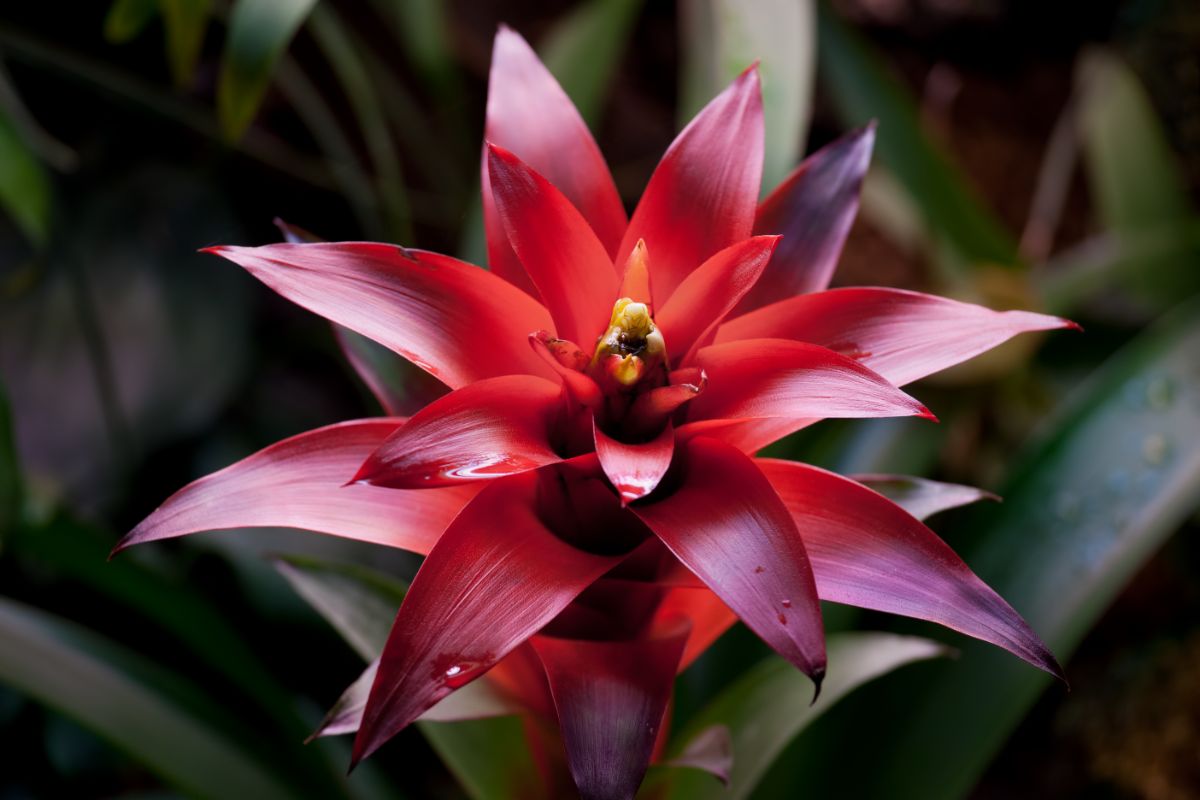
| Plant name: | Bromeliads |
| Light requirements: | Bright, indirect light |
| Water requirements: | Moderate to low |
| Toxic to pets? | No |
| Special features: | Showy flowers; Pet safe |
Bromeliads are another easygoing houseplant species that often have lots of bright red coloration. These tropical-looking plants are most famous for their bold, oversized blooms that come in an assortment of colors, including red. However, you can find bromeliad species that also have red leaves, which may or may not feature striping or other leaf patterns.
Bromeliads are monocarps, meaning they only bloom once before dying back. But, while you may just get one flower out of your bromeliad plants, those flowers make a big impact, and they last a long time. After flowering, many bromeliads will also produce ‘pups’ or baby plants, which can eventually be separated from the parent plant and potted up on their own!
11. Pencil Cactus (Euphorbia tirucalli)
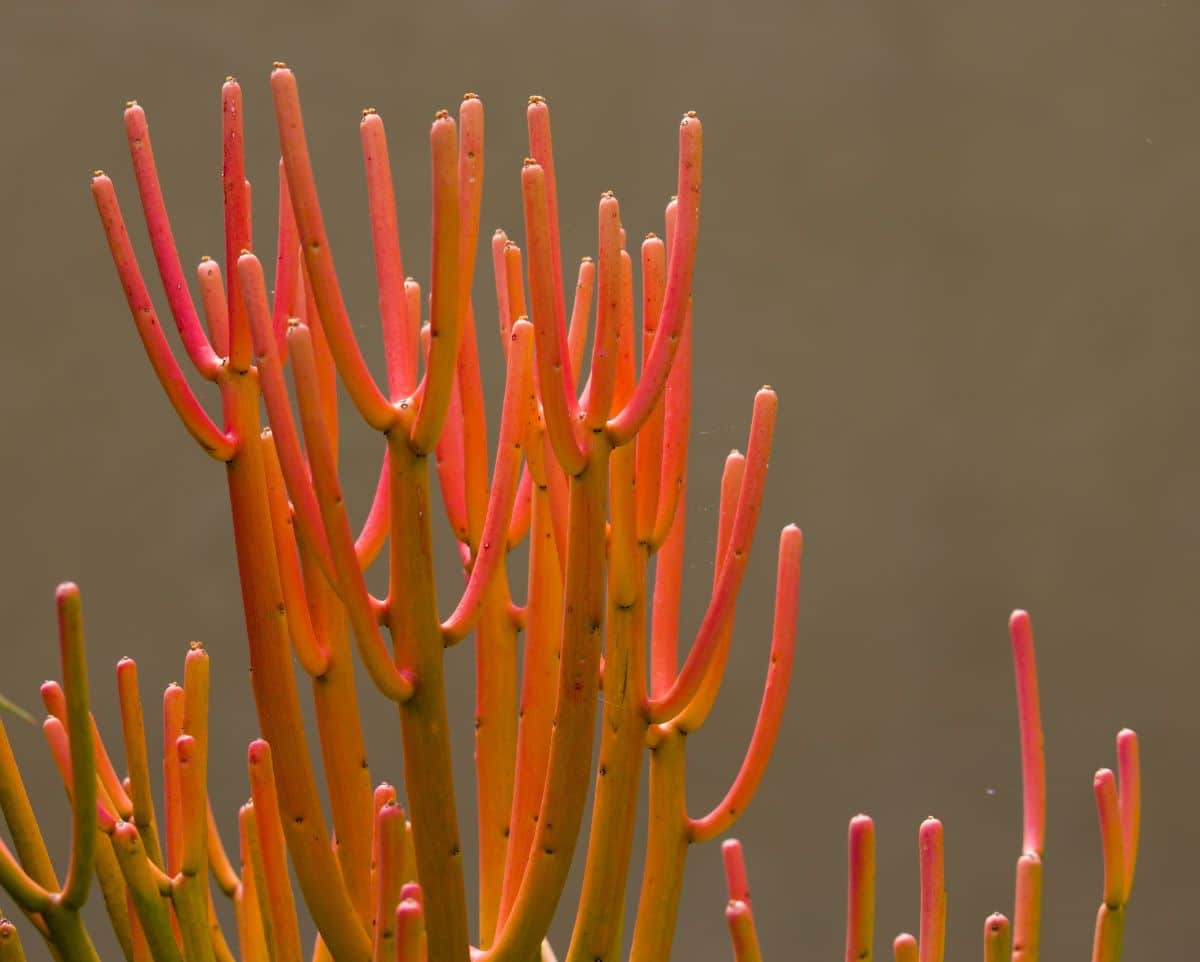
| Plant name: | Pencil Cactus |
| Light requirements: | Bright light to bright, indirect light |
| Water requirements: | Low |
| Toxic to pets? | Yes |
| Special features: | Low water needs |
Also known as “sticks on fire,” pencil cactus is a curious-looking plant with long, slender branches. Depending on the growing conditions, pencil cacti can be green, or they can develop a brilliant red coloring. Both temperature and light can intensify the coloration of pencil cacti, so if your plant’s color appears to be fading, you may want to increase the light or temperature.
Like other cacti, the pencil cactus has minimal watering needs, but it does grow best in bright light. These plants are also toxic to pets, so they may not be the best choice for homes with cats and dogs.
12. Poinsettia (Euphorbia pulcherrima)
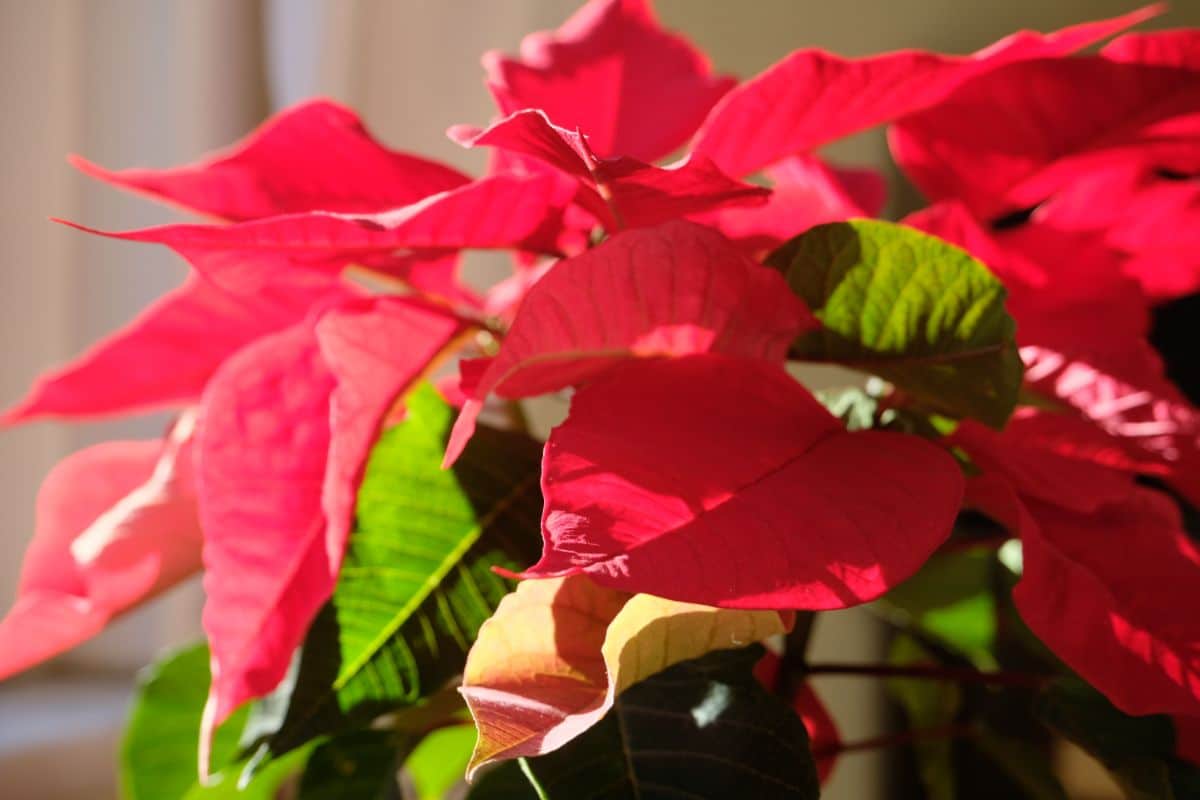
| Plant name: | Poinsettia |
| Light requirements: | Bright, indirect light |
| Water requirements: | Moderate |
| Toxic to pets? | Yes |
| Special features: | Unique leaf structure |
Poinsettia is often associated with the holidays, but these crimson beauties can be kept as houseplants all year round! The trick to keeping poinsettia indoors is to provide these plants with bright, indirect light. These plants should also be watered often enough that their soil never dries out completely.
Poinsettia flowers are not flowers at all, but they are actually modified leaf structures known as “bracts.” If you want your poinsettia to rebloom around the holidays, follow these steps to jumpstart flowering.
13. Chenille Plant (Acalypha hispida)
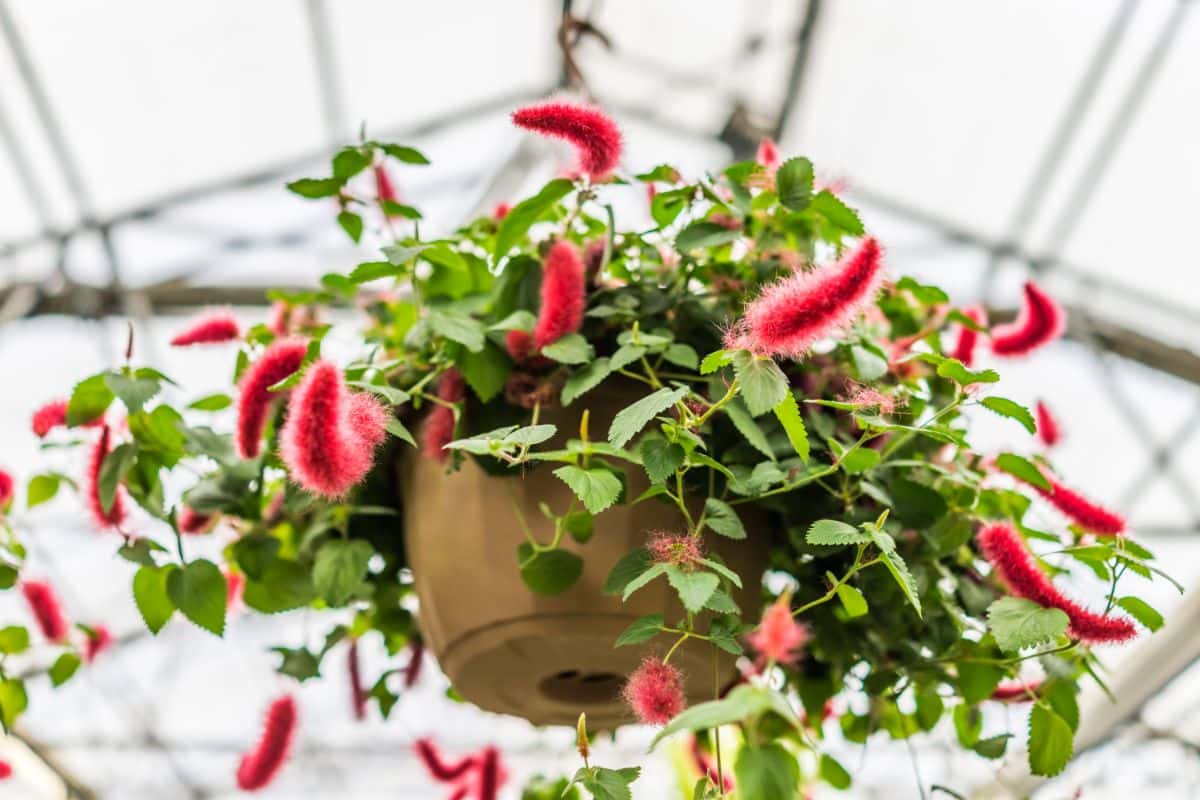
| Plant name: | Chenille Plant |
| Light requirements: | Bright light to bright, indirect light |
| Water requirements: | Moderate |
| Toxic to pets? | No |
| Special features: | Textured flowers; Good for hanging baskets; Pet safe |
If you love unusual species or textured houseplants, you’ll adore the chenille plant. This oddball tropical plant is related to poinsettia and crotons; however, unlike its colorful cousins, the chenille plant has subtle, green leaves. But chenille plants have something special: they have fuzzy, red catkins!
Chenille plant catkins can range in size from small globes to massive catkins that can reach up to 18” long. These plants are sometimes used in flower arrangements, but they make spectacular houseplants. Chenille plants are also equally well suited for hanging baskets or tabletop displays.
14. Amaryllis (Amaryllis spp.)
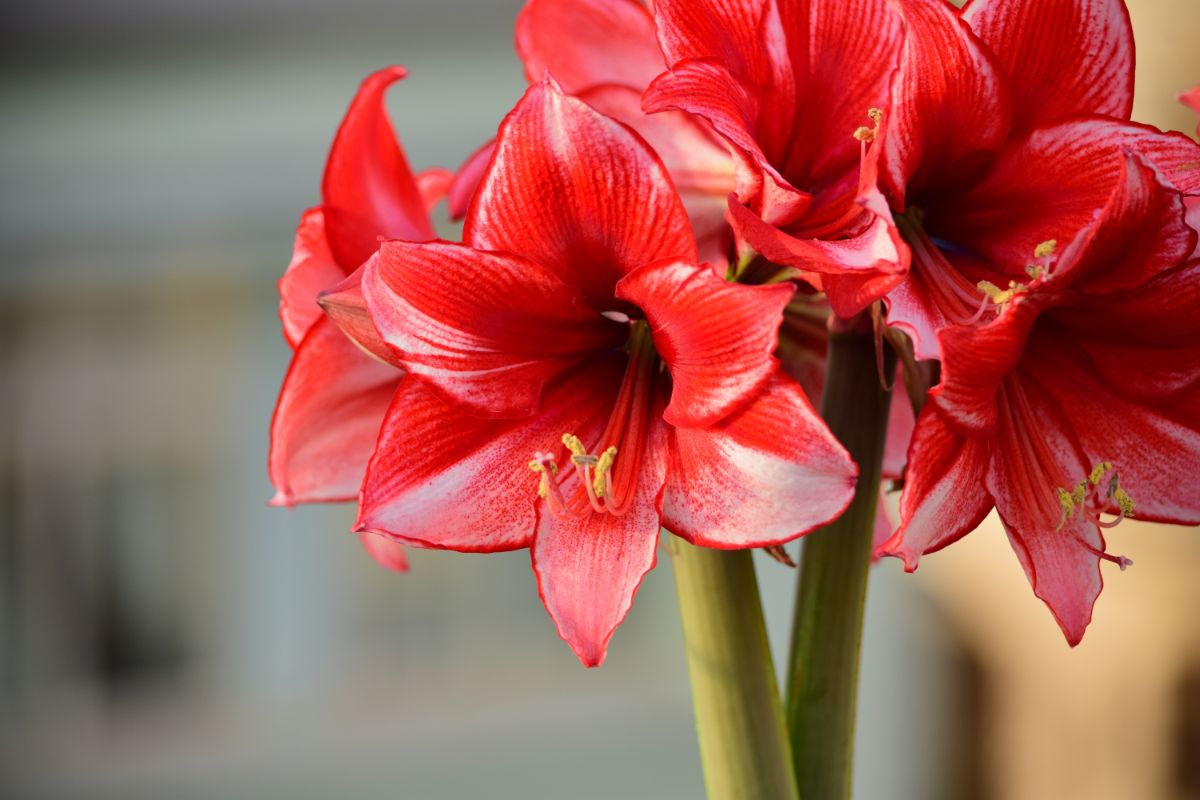
| Plant name: | Amaryllis |
| Light requirements: | Bright, indirect light |
| Water requirements: | Moderate |
| Toxic to pets? | Yes |
| Special features: | Great for small spaces |
Like poinsettia, amaryllis are commonly considered to be holiday plants, but you can keep them indoors all year round too. Amaryllis are famous for their bold, oversized flowers that come in different colors, including red. These plants also grow happily in very small pots, which makes them a great choice for apartments and other small spaces.
If you keep amaryllis all year round, your plants will grow best if their pots are placed outside during the summer. In autumn, amaryllis plants will often drop their leaves and enter into a dormant state for about 6 weeks. After this time, these plants will emerge from dormancy and begin to bloom once more!
15. Hibiscus (Hibiscus spp.)
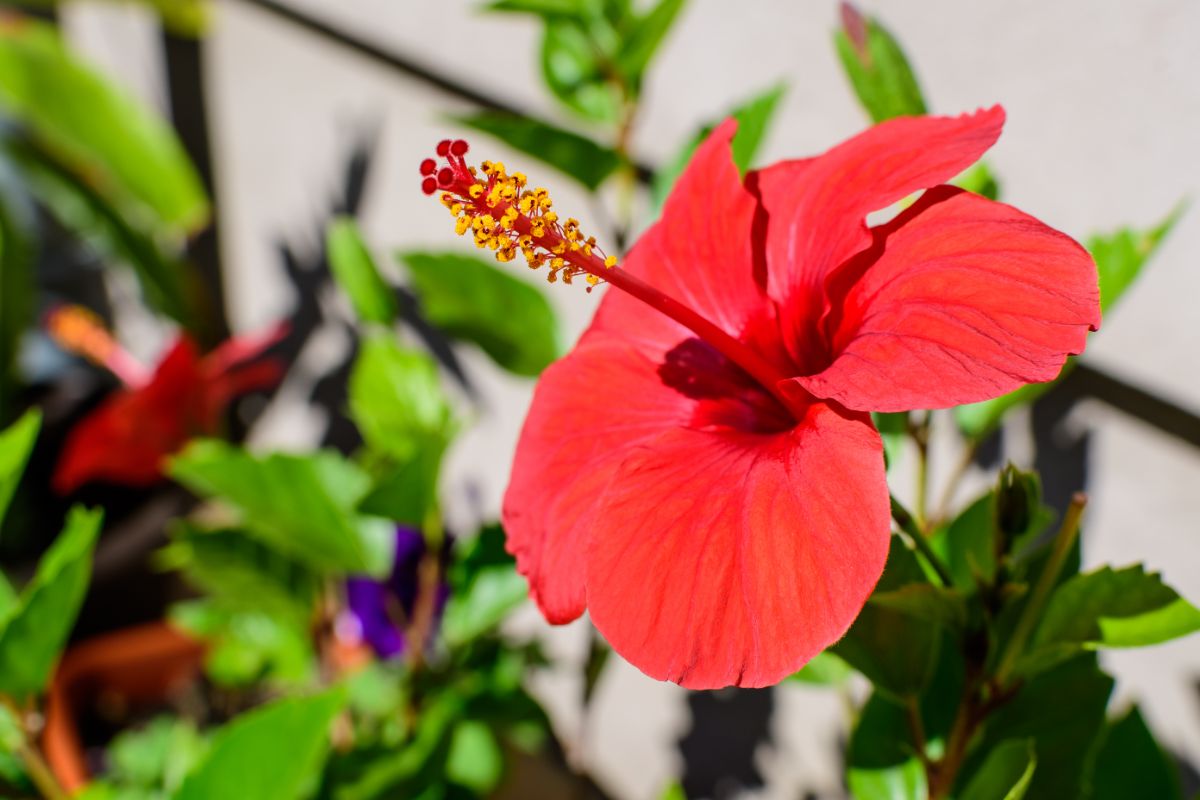
| Plant name: | Hibiscus |
| Light requirements: | Bright light |
| Water requirements: | Moderate |
| Toxic to pets? | Yes |
| Special features: | Showy flowers; Some hibiscus varieties are edible |
Hibiscus plants are commonly grown in outdoor gardens, but these showy tropicals can also be kept indoors as long as you provide them with lots of bright light. Hibiscus plants usually bloom from mid-to-late summer, and their flowers come in a rainbow of hues, including pink, white, and red. And, while many hibiscus plants can grow quite large, you can find dwarf varieties that will max out at between 2 and 3’ in height – an ideal size for container growing!
16. Red Star Dracaena (Cordyline australis)
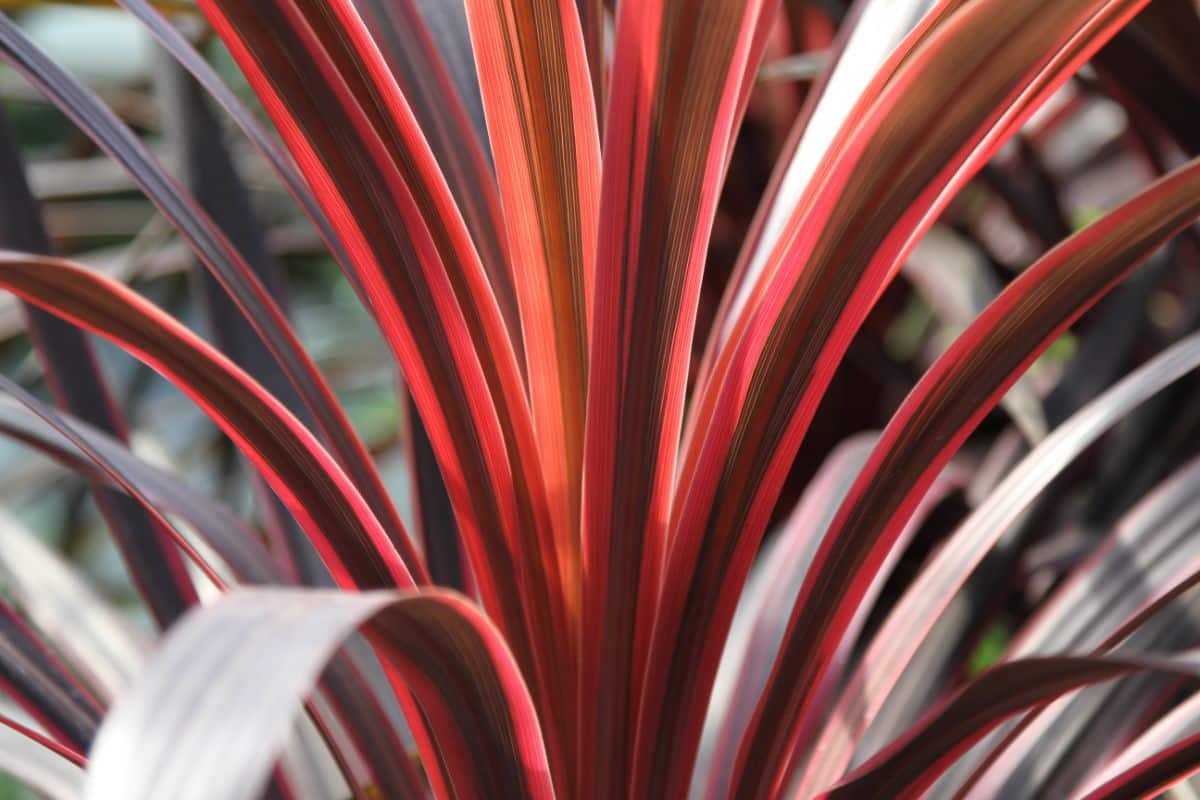
| Plant name: | Red Star Dracaena |
| Light requirements: | Bright light to bright, indirect light |
| Water requirements: | Moderate |
| Toxic to pets? | Yes |
| Special features: | Beginner friendly |
Dracaena are incredibly popular houseplants that are renowned for their striking leaves and low maintenance needs. There are over 120 recognized species of dracaena, but if you love red houseplants, the red star dracaena is a must-have. This plant has slender, grass-like leaves that are a rich red to burgundy tone, and it looks equally appealing on its own or when grown in a container with other easy-care houseplants.
17. Rubber Plant (Ficus elastica)
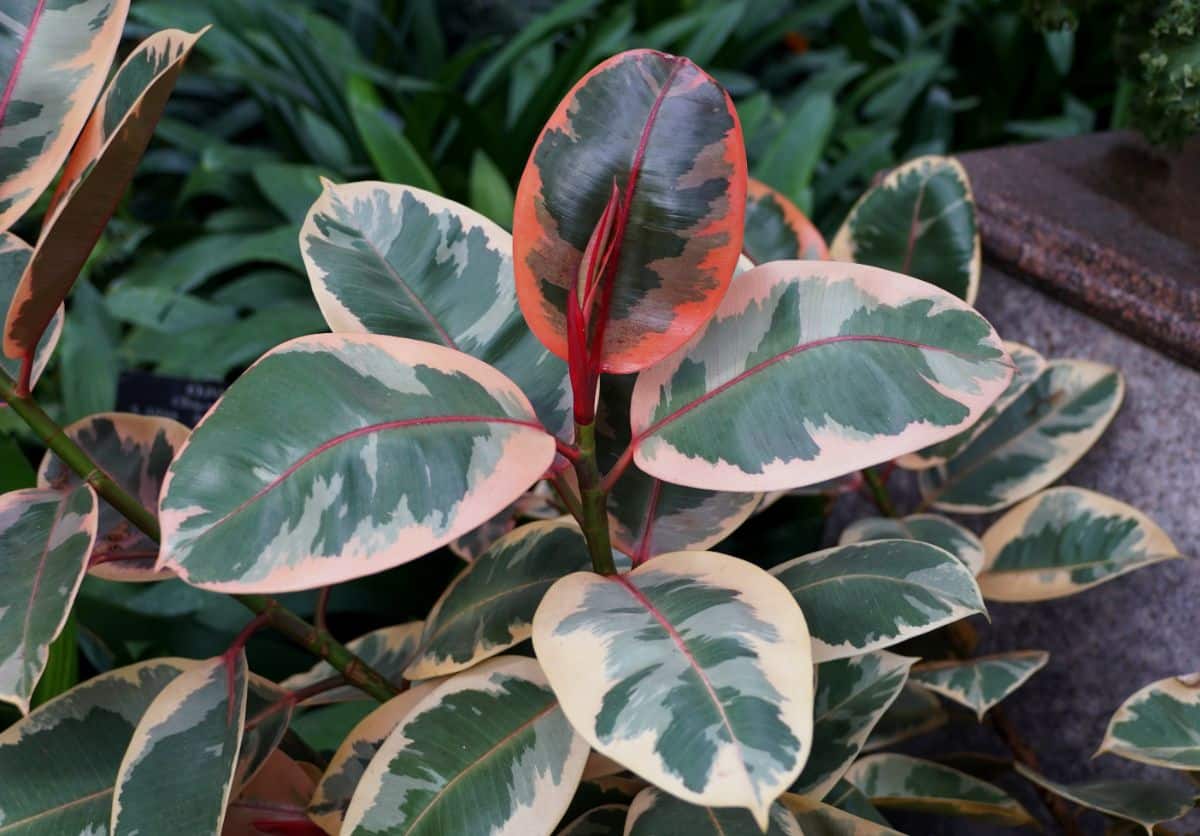
| Plant name: | Rubber Plant |
| Light requirements: | Bright, indirect light |
| Water requirements: | Moderate |
| Toxic to pets? | Yes |
| Special features: | Beginner friendly |
Rubber plants are one of the most popular houseplants today, and they can be easily recognized by their large, glossy leaves. Most often, rubber plant leaves are a rich, emerald green color, but you can find rubber plants with variegated leaves that have a pinkish-red blush as well.
Both solid green and variegated rubber plants produce red leaf sheaths when new leaves emerge. Although these leaf sheaths eventually fall off the plant, they’ll add a nice pop of color to your houseplant collection while they last. Full-grown rubber plants can grow up to 10’ tall indoors, and they will make a big impact in any home!
18. Ti Plant (Cordyline fruticosa)
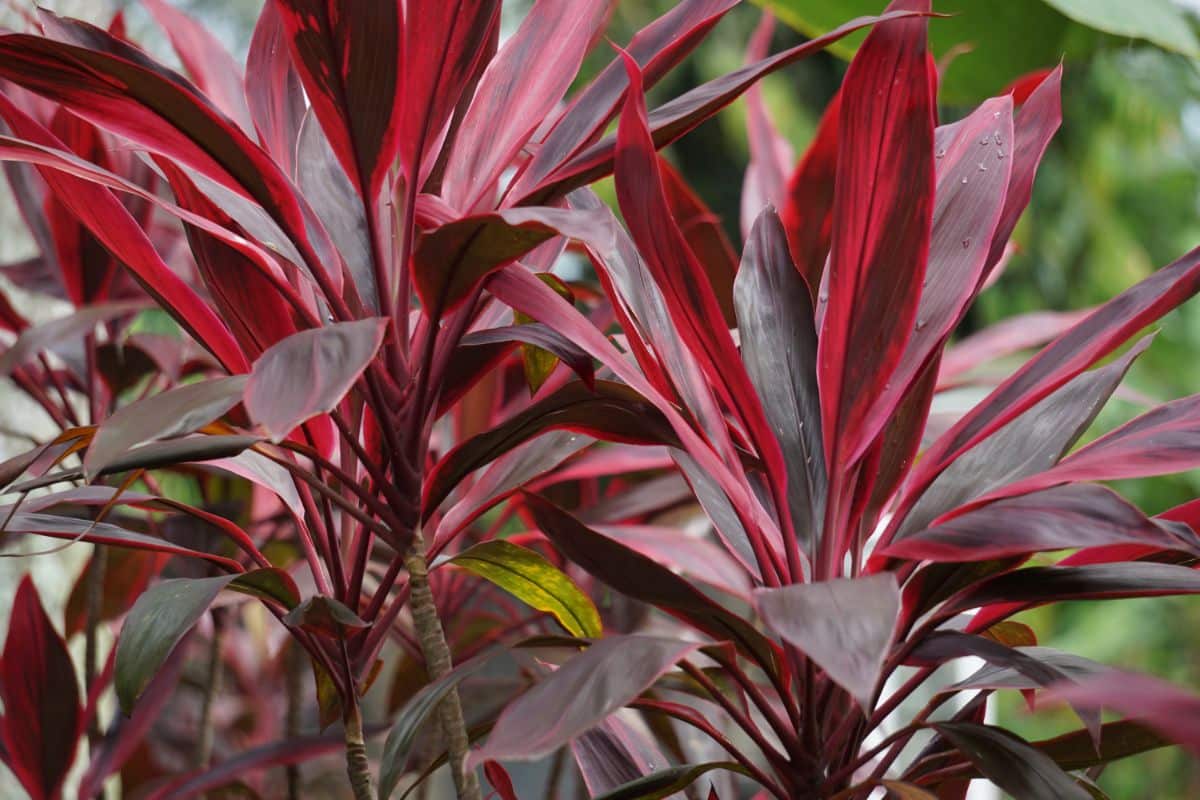
| Plant name: | Ti Plant |
| Light requirements: | Bright, indirect light |
| Water requirements: | Moderate |
| Toxic to pets? | Yes |
| Special features: | Beginner friendly |
Ti plants were once categorized as dracaena plants, and they can look quite similar to red star dracaena and other related species. However, Ti plants and dracaena have several notable differences, including different root colors and berry forms.
Ti plants are sometimes known as good luck plants, and they are notable for their colorful leaves, which are streaked in various tones. Some Ti plants have more red coloration than others, but they are all eye-catching plants. When grown outdoors, Ti plants can flower and produce berries, but this is less common when these plants are kept inside.
19. Red Edged Radiator Plant (Peperomia clusiifolia)
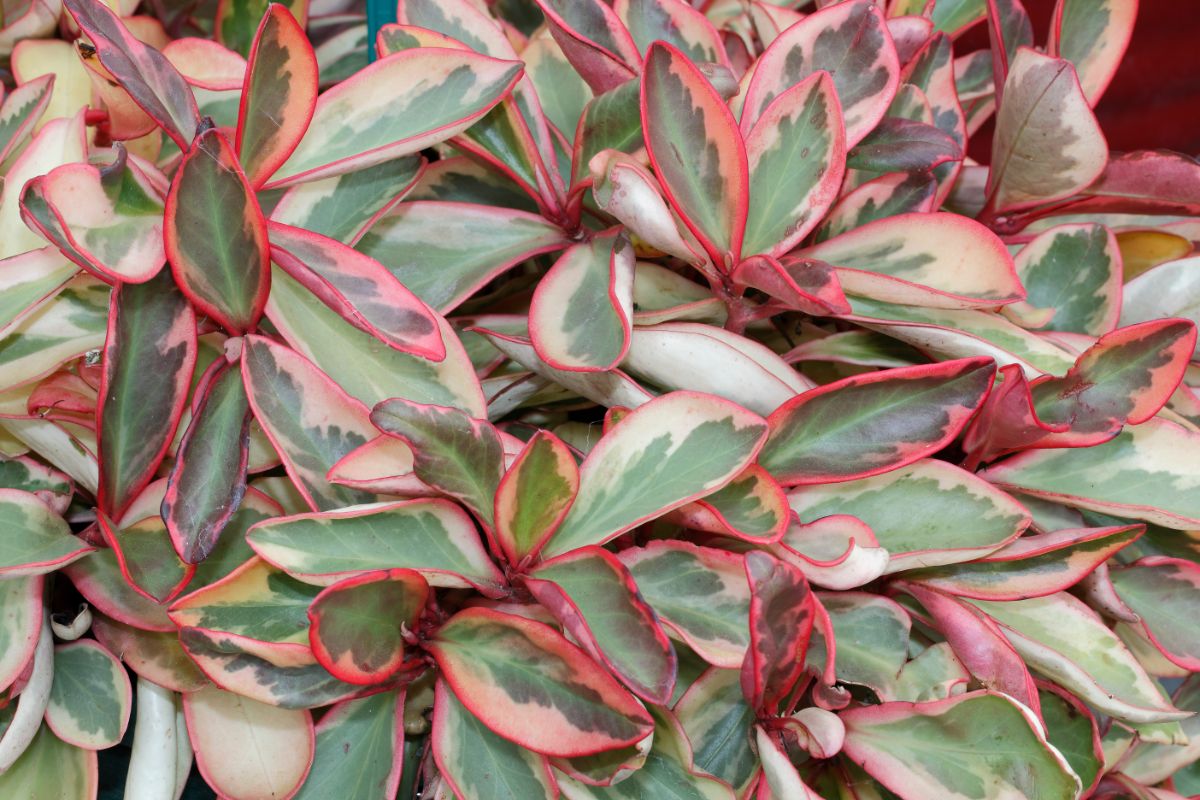
| Plant name: | Red Edged Radiator Plant |
| Light requirements: | Bright, indirect light |
| Water requirements: | Moderate to low |
| Toxic to pets? | No |
| Special features: | Pet safe |
Radiator plants may have a funny name, but they still make spectacular houseplants, especially if you can get your hands on a red-edged radiator plant cultivar! This plant’s name comes from the fact that peperomia love growing in warmer spots, such as near radiators. Like other peperomias, the red-edged radiator plant is non-toxic, so it is perfectly safe to keep in homes with pets!
20. Crown of Thorns (Euphorbia milii)
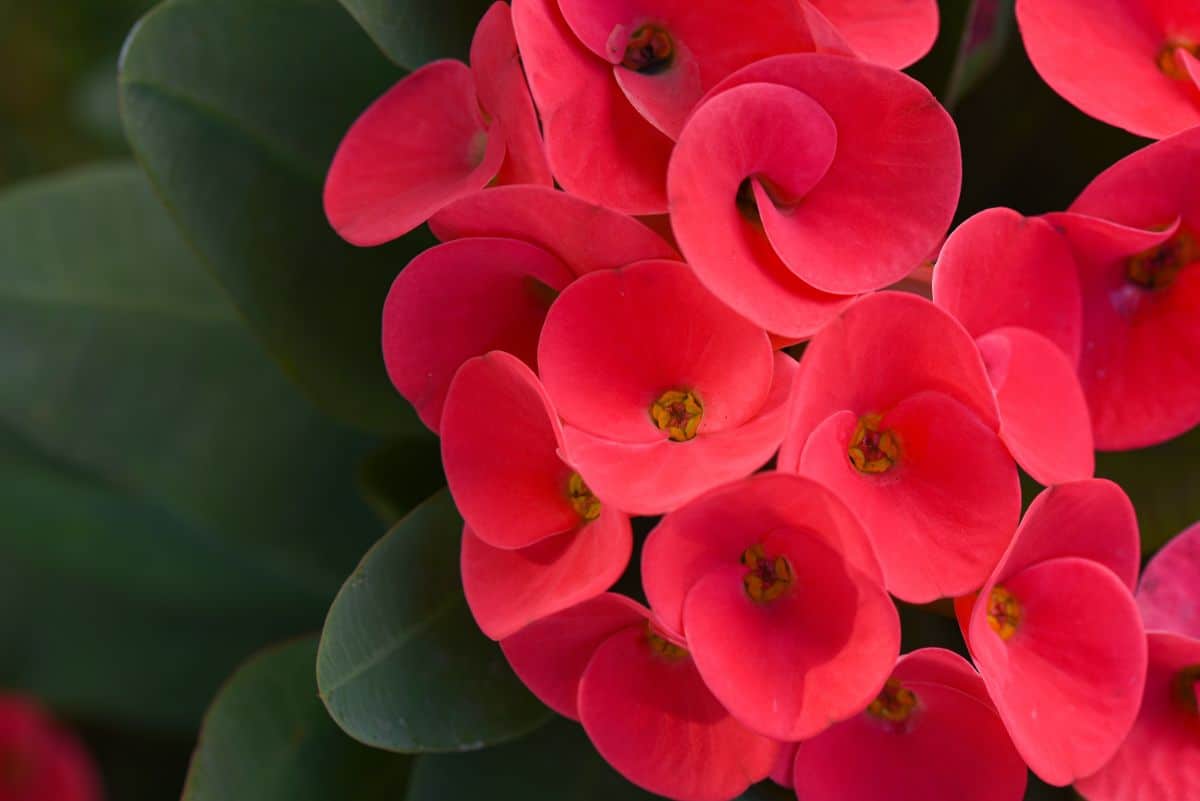
| Plant name: | Crown of Thorns |
| Light requirements: | Bright light |
| Water requirements: | Moderate |
| Toxic to pets? | Yes |
| Special features: | Beginner friendly |
The crown of thorns is an unusual-looking succulent plant with thorny stems and brightly colored flowers. Most often, the crown of thorns plants bloom in spring and summer, but with proper care, you can keep them flowering all year round. Crown of thorns flowers come in many different colors, including red, white, and pink.
While crown of thorns is a succulent, it will grow best with regular watering. If these plants are allowed to get too dry, they may begin to drop some of their lower leaves. Additionally, like other Euphorbia plants, crown of thorns are also toxic to pets, so keep them out of the way of your furry friends!
21. Caladiums (Caladium spp.)

| Plant name: | Caladiums |
| Light requirements: | Bright, indirect light |
| Water requirements: | Moderate |
| Toxic to pets? | Yes |
| Special features: | Highly ornamented leaves |
Like hibiscus and coleus, caladiums are often grown outdoors, but they can also make exceptional houseplants as long as you understand their care requirements. Caladiums need to be watered regularly, and they will also grow better if you boost humidity levels in your home with a humidifier or pebble tray. These plants should also be kept out of bright windows as too much direct light can damage their colorful leaves.
22. Coleus (Coleus spp.)

| Plant name: | Coleus |
| Light requirements: | Bright, indirect light |
| Water requirements: | Moderate |
| Toxic to pets? | Yes |
| Special features: | Highly ornamented leaves |
Coleus are normally kept outdoors as foliage plants in garden beds and containers; however, these eye-catching plants can be kept inside too. While coleus plants come in many different colors, you can find cultivars with rich, red, or maroon leaves that are sure to brighten up any windowsill or sunny shelf. When grown indoors, coleus needs lots of bright, indirect light, regular watering, and extra humidity to prevent overly dry leaves.
23. Desert Rose (Adenium obesum)
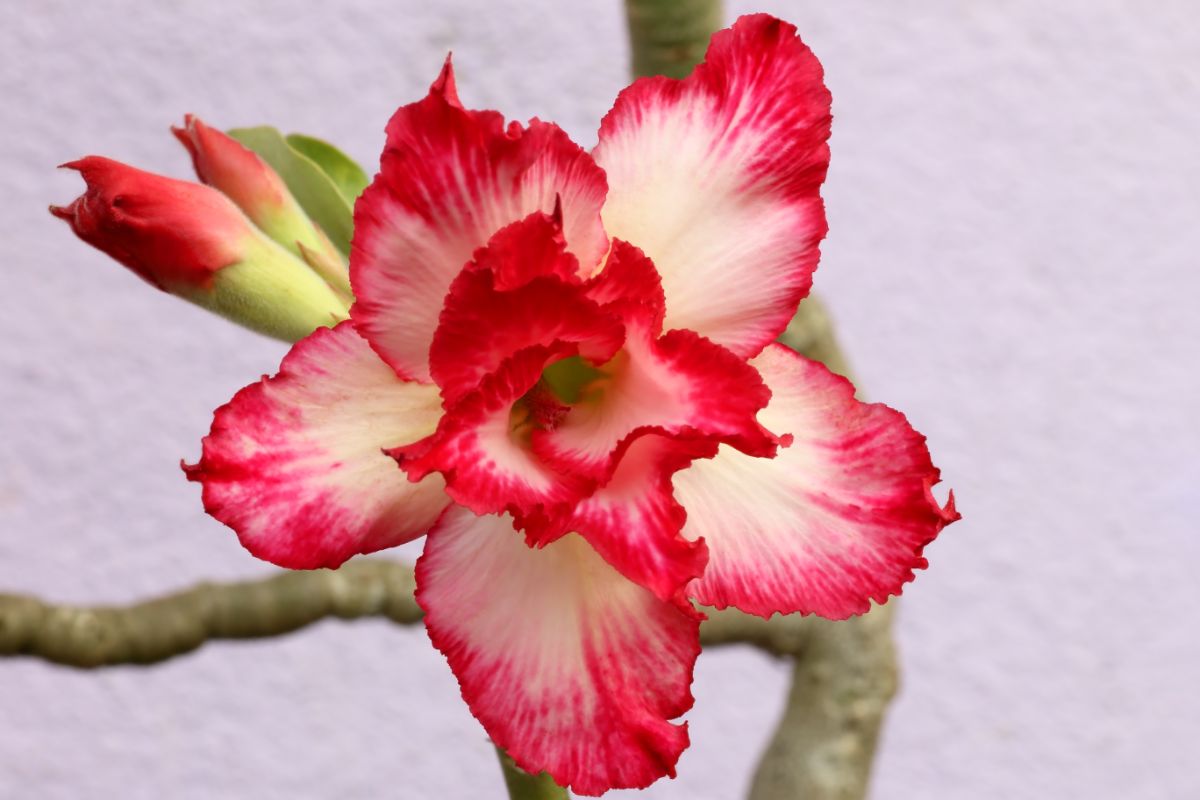
| Plant name: | Desert Rose |
| Light requirements: | Bright light |
| Water requirements: | Low |
| Toxic to pets? | Yes |
| Special features: | Showy flowers; Unusual stem form |
Desert rose has a unique form with a thick, succulent trunk, which the plant uses for water storage. But the real draw of desert rose plants are their colorful flowers which are usually a rich, pink color. However, if you’re looking for red plants, you can find desert roses with red blooms too.
Desert roses are slow-growing plants that are often used for bonsais, although they make wonderful tabletop plants as well. Like other succulents, desert roses have low watering needs, and they should be kept in bright light to prevent stretching and leggy growth.
24. Rex Begonia (Begonia rex)
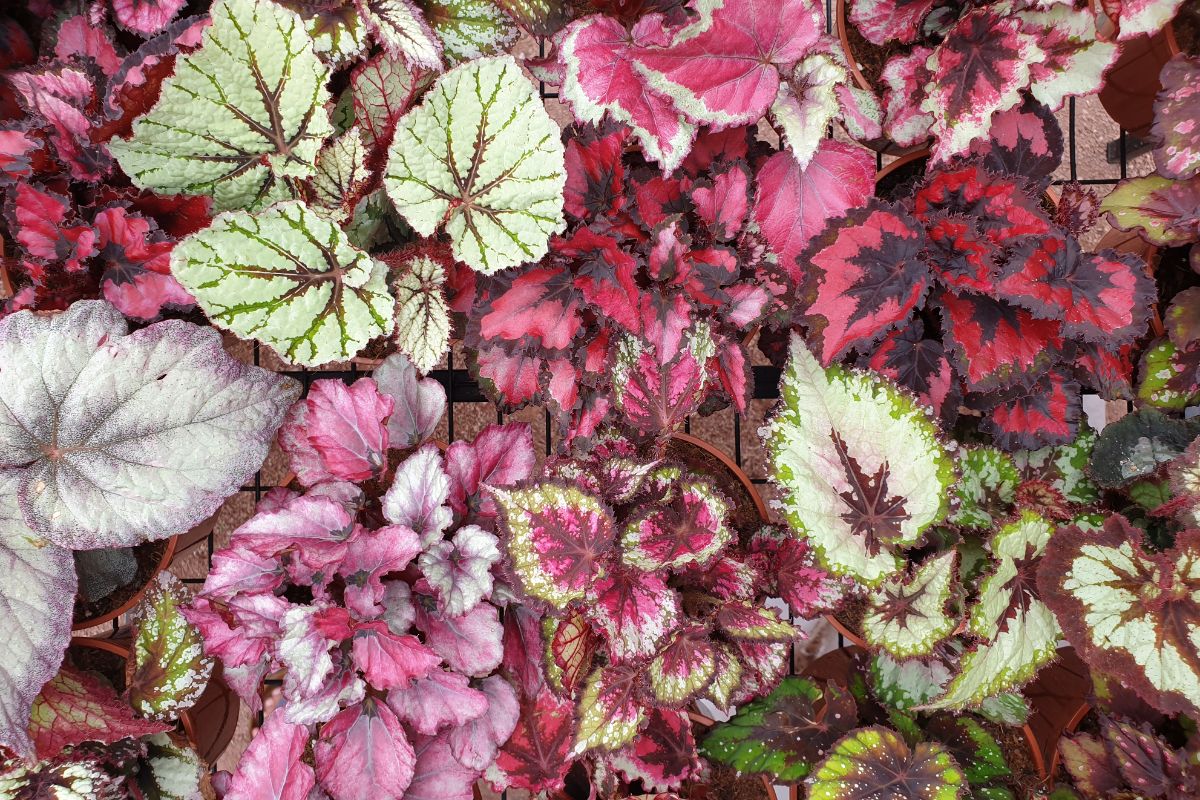
| Plant name: | Rex Begonia |
| Light requirements: | Bright, indirect light |
| Water requirements: | Moderate |
| Toxic to pets? | Yes |
| Special features: | Highly ornamented leaves |
Rex begonias are some of the most well-known begonia varieties, and you can find them in an assortment of colors, including red. These plants are often grown outdoors in containers, but they can also be kept indoors all year round with proper care. Rex begonias are generally quite easy to maintain, but they will grow best with higher-than-average humidity levels.
25. ‘Red Log’ Peperomia (Peperomia verticillata)
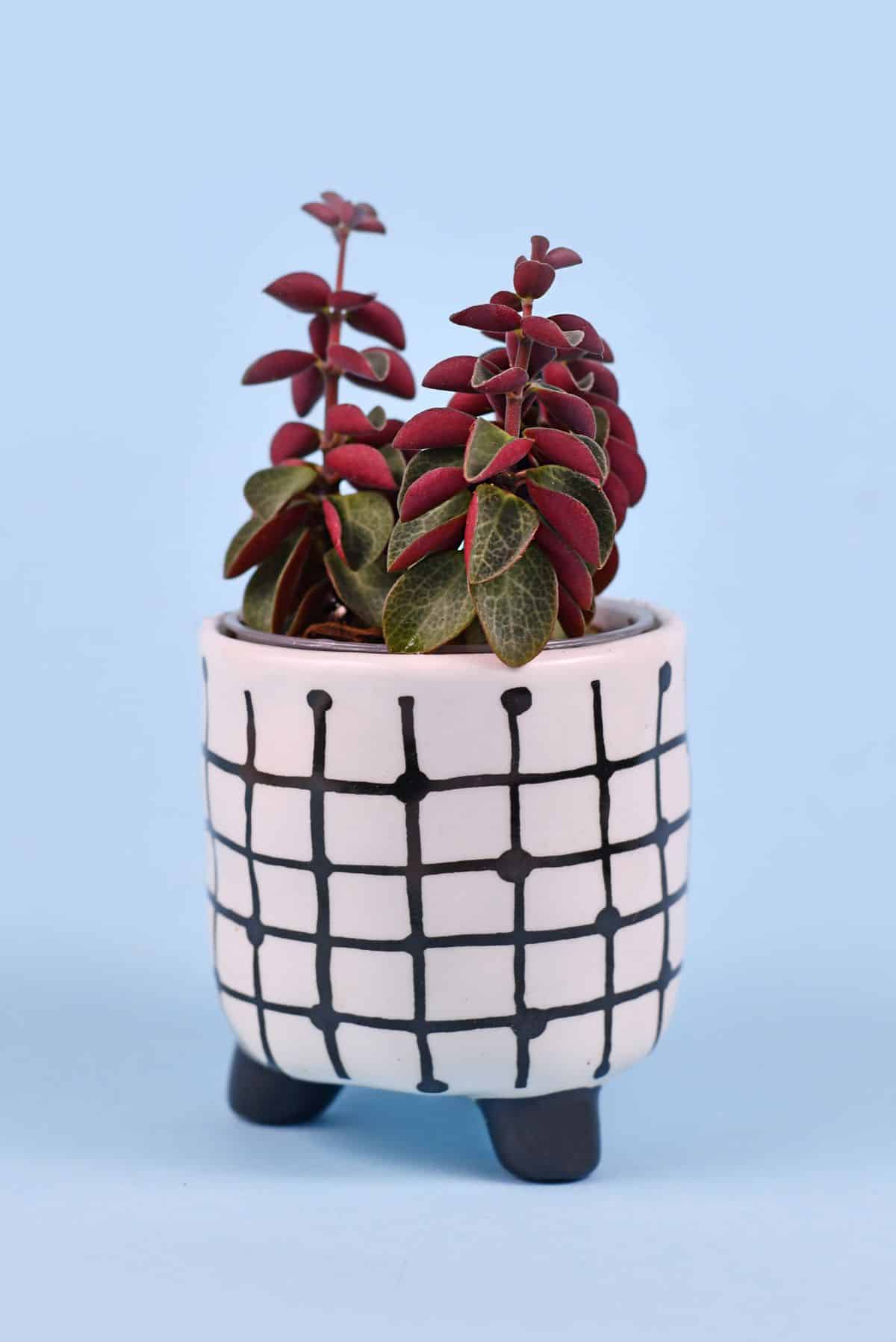
| Plant name: | ‘Red Log’ Peperomia |
| Light requirements: | Bright, indirect light |
| Water requirements: | Moderate |
| Toxic to pets? | No |
| Special features: | Pet safe |
Peperomia is a very large family of plants that contains over 1500 species, including the radiator plant. But if you love the color red, you can also try out the ‘Red Log’ peperomia, which has a warm, crimson coloration to the undersides of its chunky leaves.
‘Red Log’ plants usually maintain an upright growth habit when they’re younger, but they can begin to trail and vine as they age. ‘Red Log’ plants can be kept more vertical with trellising, but they look particularly alluring when allowed to cascade from hanging baskets.
Summary
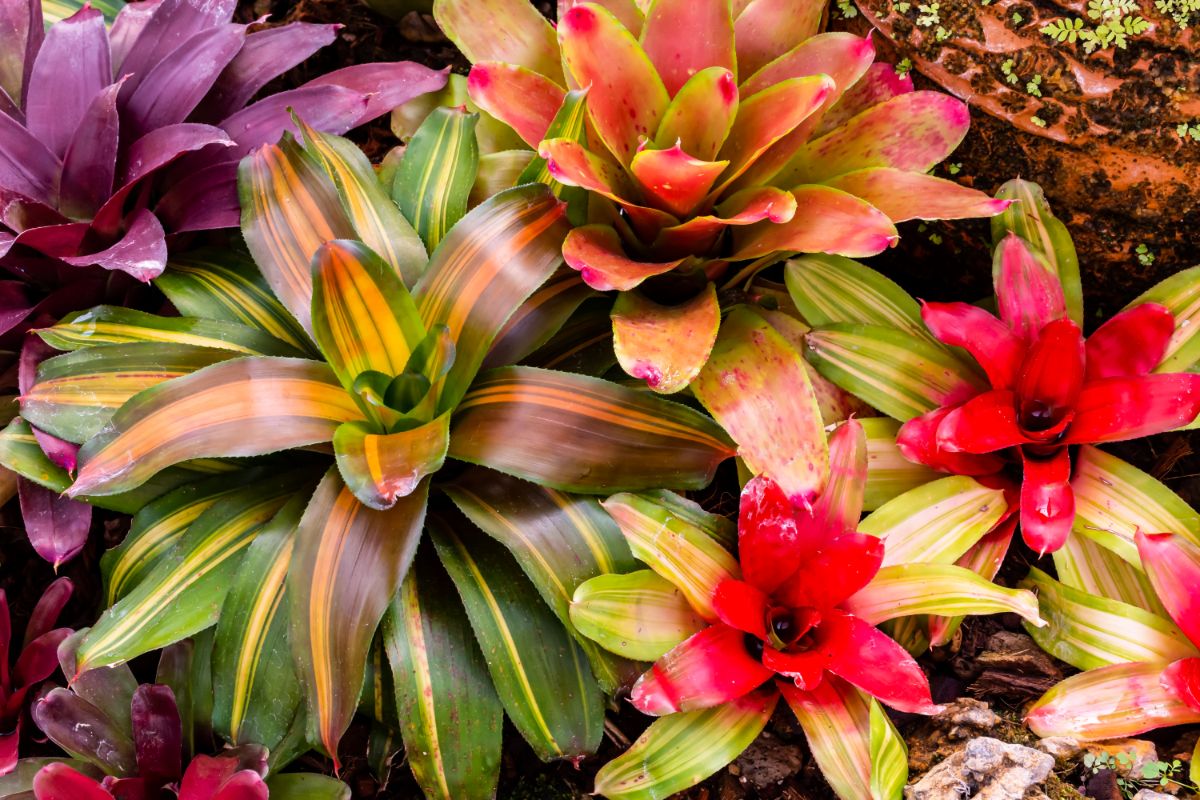
From cherry red moon cacti to the crimson blooms of desert roses and hibiscus, there are tons of red houseplants available today. These plants can look stunning on their own, but they can make an even greater impact when they’re grown en masse in a large houseplant collection. Depending on your taste and style, you can interplant red houseplants with green plants, or you can grow only red plants for a truly, one-of-a-kind display!
While we hope you enjoyed this guide on red houseplants, if you’re still looking for the perfect indoor plant for your home, check out our guide on popular, easy-care plants or play with patterned plants with this guide on striped houseplants.

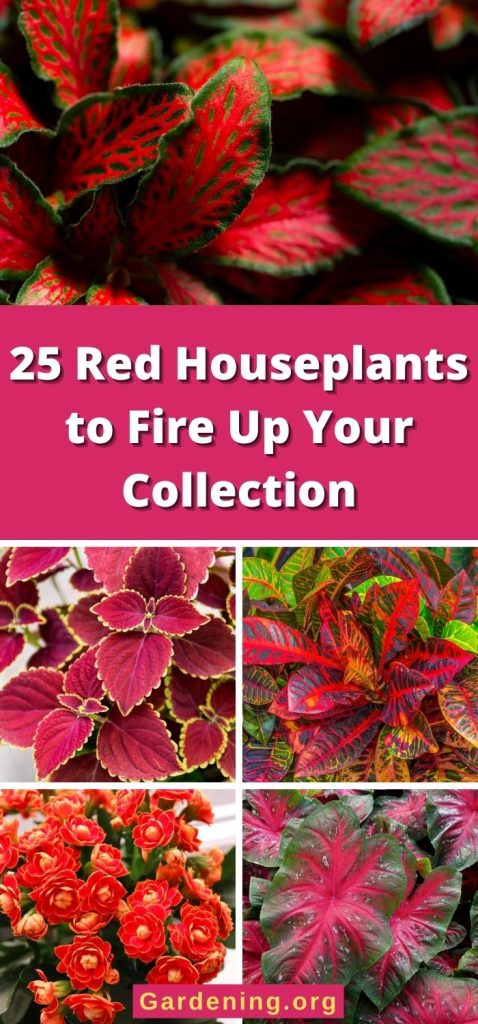
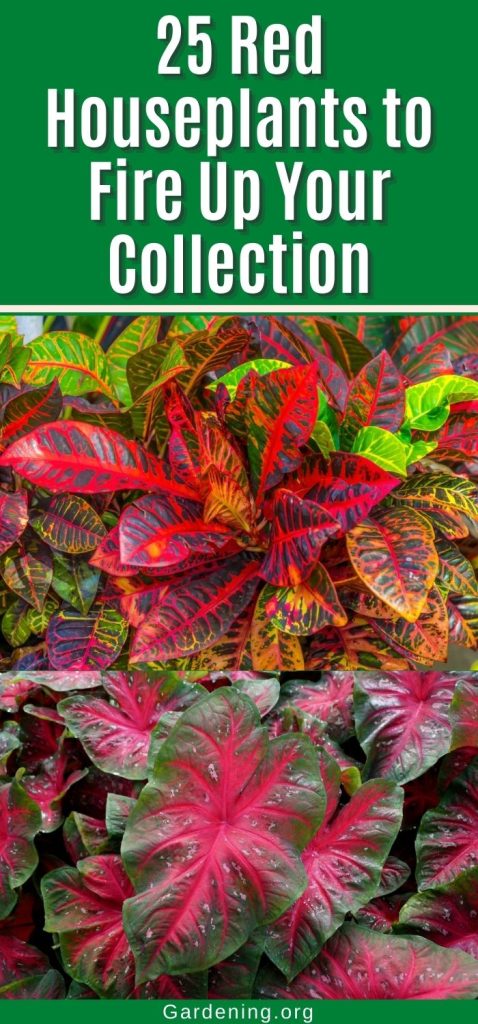
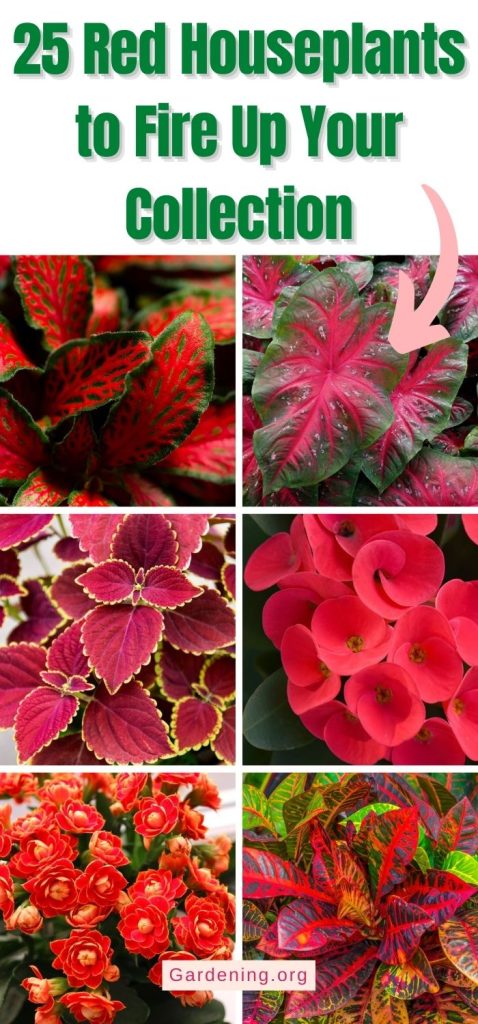
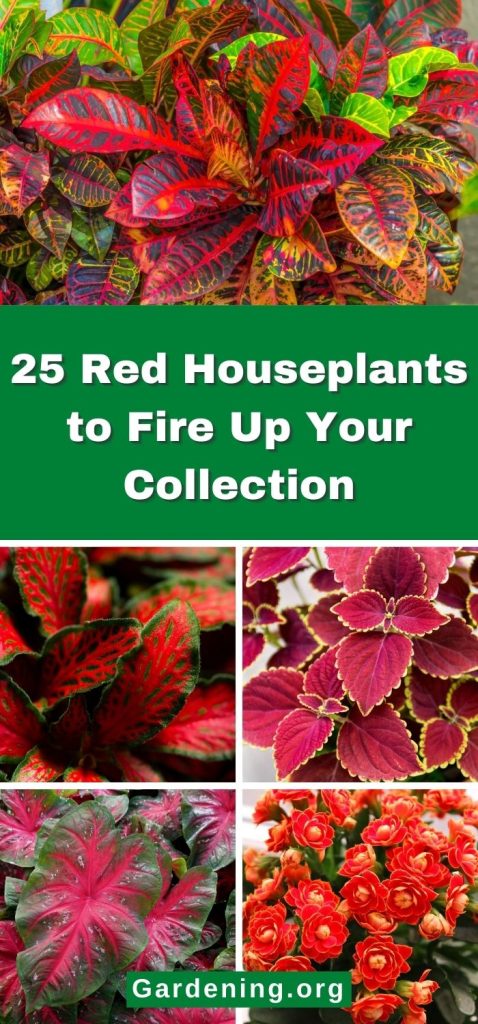
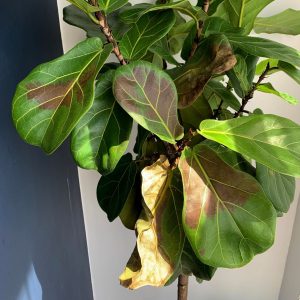
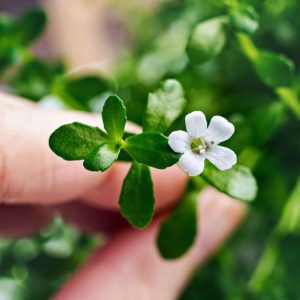
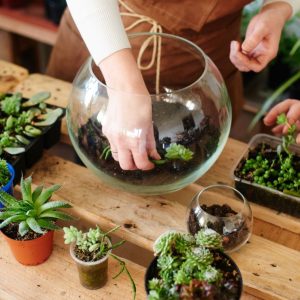
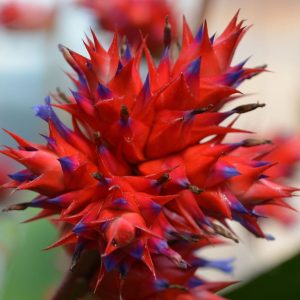
Leave a Reply